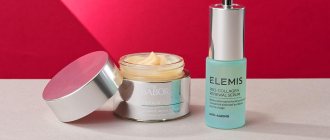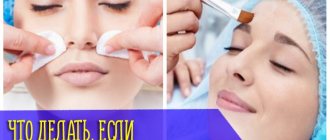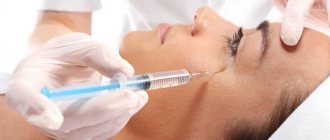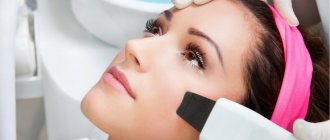Peeling is a complex skin procedure that causes severe peeling of tissue. This phenomenon is natural, so everyone should prepare for the fact that their face will not look very aesthetically pleasing for some time.
If you follow some rules and post-peeling care, then after some time the traces of exposure will disappear. However, the procedure can cause side effects if you refrain from taking advice from specialists in the field of cosmetology after it is performed.
What happens to the skin after peeling
Acids and alkalis used during peeling have a strong effect on the skin. Therefore, it is important to familiarize yourself with all the nuances before the procedure.
The natural reaction to cleaning fabrics in this way is to:
- Peeling or flaking in small areas. Such processes can last from several days to several weeks. The duration depends on the type of peeling, the concentration of the solution and the characteristics of the body.
- Redness. It often occurs after a medium-strength peel. In the first hours after the procedure, the highest degree of skin redness is observed. After a few hours or days, the skin acquires a pink tint.
- Mild swelling. Especially in the eyelid or neck area, since these areas have the most delicate tissue.
Such symptoms are an acceptable norm, which a specialist should warn about in advance. However, with proper care, the regeneration process will take place in the shortest possible time and without complications.
If the skin is exposed to negative effects after peeling, the symptoms become much more complicated. It is especially dangerous if you tear off the skin after peeling.
Water blisters, scars, keratinized areas, hyperpigmentation, etc. may appear on the face. In such circumstances, it is recommended to urgently seek medical advice. He will prescribe the necessary antibacterial and restorative treatment.
Consequences of the procedure
A cosmetologist should explain what happens to the skin after peeling and what is considered a normal reaction. He is also obliged to give advice on the proper care of sensitive skin after the procedure.
Redness
Redness of the tissues necessarily appears during the rehabilitation period after peeling. As already mentioned, redness is associated with the effect of the burn, so after peeling it is very important to pay special attention to treatment and proper facial care.
We recommend: 3 reasons why the skin peels off after peeling, and what to do in this case?
How long the redness will persist depends on how deeply the chemical components penetrate the dermis. The degree of redness can vary from light pink to red, but sometimes there may be no reaction at all. As a rule, the skin recovers after peeling for 5 or more days, but peak redness is observed immediately after the procedure.
Peeling
Peeling is also a normal reaction. Just like redness, the duration of shedding of dead cells depends on the type of procedure, the concentration of the composition and the individual skin reaction. You must understand that such discomfort can continue for a week, and only after that can you truly appreciate all the benefits of peeling.
Mild swelling
If intensive reagents were used during the procedure, swelling is possible. In addition, even moderate peeling in the neck and eyelids can be accompanied by swelling and swelling. This is due to the fact that very delicate tissues were exposed, so this reaction is also considered acceptable.
Persistent redness and swelling is a reason to consult a doctor; there may be an allergic reaction that requires antihistamine therapy.
Is it possible to rip off the skin after peeling?
Chemical peeling is a serious stressor for the skin. When applying the solution, tissues receive serious burns. Its strength depends on the concentration of the composition.
The damaged layers of the epidermis begin to gradually separate in the form of a film or crust, and a new skin (elastic and elastic) forms under them. Visually, this process does not look very aesthetically pleasing, so many patients after peeling try to peel off the exfoliated layers.
However, doing this is strictly prohibited. Otherwise, infection or bacteria may penetrate the skin. The consequences include the formation of scars or other skin defects. In addition, tearing off the crust will increase the regeneration time.
As a last resort, it is recommended to carefully trim pieces of loose skin using scissors (pre-disinfected).
The most important mistakes in post-peeling care
An important link influencing the regeneration processes is preparation. Without correctly determining the skin type, the intensity of penetration of acids or the depth of action of hardware procedures, it is difficult to say how the recovery will proceed. Dermatological features also influence the result. In addition, women make a number of mistakes that nullify the procedure. It is forbidden:
- Peel off the skin after peeling.
- Use gels, foams, and soaps for washing.
- Stay outside for a long period of time under the influence of the sun's rays.
- Apply physical pressure with brushes to the injured skin of the face.
- Use masks, creams, serums.
- Visit baths, steam rooms, and the gym.
- Sunbathe.
- Do not use protective creams 35 SPF or higher.
- Allow aggressive action on the skin.
- Apply cosmetics (even decorative ones).
It is recommended to carry out the facial cleansing procedure during the weekend or while on vacation. Layers of exfoliation on the face do not look very aesthetically pleasing, and the cosmetologist’s instructions on why you should not peel off the skin during the healing process sound more than convincing.
Other mistakes after peeling are presented in the video:
What to do if your skin is ripped off after peeling
Despite the fact that you should not peel off dead skin, specialists often encounter patients who neglect this rule. Under such circumstances, cosmetologists and dermatologists recommend using the following products:
- Wound healing ointments (Panthenol, Bepanten). Depending on her condition, apply 3-5 times a day. The product helps speed up regeneration and alleviate the general condition of the facial skin.
- Hypoallergenic cosmetics that do not contain fragrances or chemical additives.
- Preparations based on antioxidants, hyaluronic acid, glycerin, etc.
Using these products will improve the condition of your skin. However, it is almost impossible to completely correct the consequences of the procedure.
Expected effect:
- intensive skin rejuvenation,
- smoothing out fine and deep wrinkles,
- relief leveling
- elimination of stretch marks, scars
- elimination of hyperpigmentation
Medium peeling usually requires pre-peeling preparation. This could be the home use of creams or lotions containing light exfoliating and renewing ingredients, such as fruit or AHA acids. With proper preparation, the skin is “trained” before the most aggressive impact, which will shorten the rehabilitation period, improve skin regeneration and get a more pronounced result. Also, to prepare the skin for medium peeling, it is recommended to first undergo 1-3 sessions of superficial peeling.
Recommendations from cosmetologists
Each cosmetology specialist gives patients recovery advice before and after the peeling procedure. They help achieve rapid and painless regeneration of new tissue.
So, the list includes the following tips:
- For a natural course of the recovery period, it is recommended to exclude the use of decorative cosmetics (powder, foundation, concealer) for some time. This advice is related to the possibility of infection, which may be contained in the listed products. In addition, particles of cosmetics contribute to clogging of pores, which visually worsens the appearance.
- You cannot visit bathhouses, saunas or other establishments of this type. It is also not recommended to overload the body with significant physical activity. Both of these actions contribute to the release of sweat, which is a source of infection. Another reason for this prohibition lies in the dilation of blood vessels, which preserves the redness of the face. The same consequences are expected if you consume alcoholic beverages, fatty or spicy foods.
- Avoid washing your face with water for the first few days.
- Use only those care and restoration products that were recommended by a cosmetologist. Most often, such products have a high moisturizing effect.
However, one of the main pieces of advice is to immediately contact a specialist in case of side effects due to tearing off, infection, etc. Self-medication can lead to irreparable consequences.
After dry cleaning through peeling, it begins to peel off significantly. Doctors strictly prohibit peeling off dead skin in order to preserve the result and protect the integument.
How is the TCA peel procedure performed?
The TCA peel procedure is quite sensitive. When applied to the skin, a fairly intense burning sensation occurs after 1-2 minutes, but it passes quickly. Then the so-called “frost” forms on the skin - a white coating consisting of coagulated upper layers of the epidermis. It is practically invisible and easily washed off. TCA peeling may not be accompanied by any redness, so the patient does not observe any changes in the skin immediately after the procedure. However, a pronounced vascular reaction and slight swelling are also possible and depend on the individual characteristics of the skin. 2-3 days after the procedure, a dark crust forms in the peeling area, which completely disappears within 5-7 days. Young skin after the crust has peeled off is pink; over the course of several days it gradually acquires its normal color. It is very important to use sunscreen or avoid sun exposure altogether for at least two weeks to prevent pigmentation from forming in the peeling area.
Rules of behavior after the procedure:
- avoid thermal procedures (sauna, steam bath, hot shower) for 2 weeks after the procedure
- Avoid skin exposure to sunlight and use SPF 50 sunscreen
- Gently cleanse the skin; in case of severe tightness, use light moisturizers
- try to avoid strong tension and activity of the facial muscles, as this can lead to cracking of the crust and longer healing
The recommended course of TCA is 15%, 25%, 35% from 1 to 5 procedures, once every 1.5 - 2 months.
How long does it take for the epidermis to peel off?
You can roughly estimate the length of the recovery period by taking into account the type of drug used.
- If the patient undergoes the procedure for the first time, he is offered a superficial type of peeling, in which a product with a low acid concentration is used. In this case, the skin begins to peel off on the 3rd day. And the exfoliation period lasts another 3 days.
- If the patient has undergone a mid-peeling procedure, recovery will last about a week. After deep cleansing, regeneration will take about 2 weeks.
Preparing for peeling
Peeling is preceded by a preliminary consultation, during which the doctor determines the patient’s skin type and selects the most suitable type of peeling. Also during the consultation, the doctor finds out whether the patient has any possible contraindications for the upcoming cleansing procedure. Contraindications to acid peeling are:
- pregnancy and lactation;
- chronic diseases;
- oncology;
- skin diseases,
- skin damage;
- recurrent herpes.
If the patient is taking antibiotics, hormonal agents and other medications, he must inform the doctor about this, since this information must also be taken into account when choosing the type of peeling and assessing the admissibility of the procedure.











